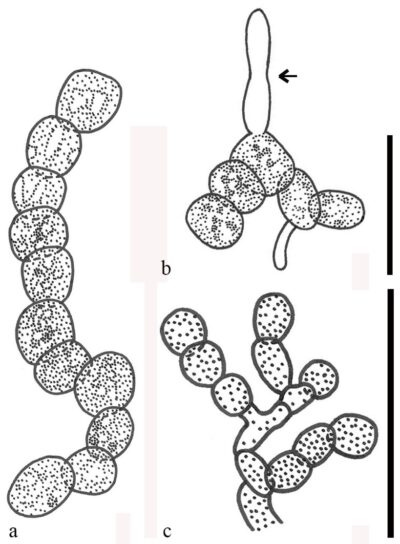Fungalpedia – Note 393, Perusta
Perusta Egidi & Stielow
Citation when using this data: Tibpromma et al. 2024 (in prep.) – Fungalpedia, Rock-inhabiting fungi.
Index Fungorum, Facesoffungi, MycoBank, GenBank, Fig. 1
Classification: Incertae sedis, Capnodiales, Dothideomycetidae, Dothideomycetes, Pezizomycotina, Ascomycota, Fungi.
The monotypic genus Perusta was erected by Egidi et al. (2014) and typified with Perusta inaequalis. The concatenated rDNA (18S, 5.8S, 28S) phylogeny formed a stable clade and the genus is characterized by compact, hard, black in reverse colonies, greyish in obverse, not uniform in color, with irregular margins. Hyphae are dark brown, septate, finely guttulate, with thick walls, consisting of round and chained cells with lateral germination with semi-macronematous conidiophores and intercalary conidiogenous cells with catenate conidia. Perusta, erected by Egidi et al. (2014), is an invalidated taxon under Nom. inval., Art. 40.7 (Shenzhen), and later validated by Crous et al. (2019). Perusta is a monotypic genus that has been isolated from rocks in Spain (Egidi et al. 2014).
Type species: Perusta inaequalis Egidi & B. Stielow
Other accepted species: This genus is monotypic.
Figure 1 – Perusta inaequalis (CBS 118271=TRN272). a, b Hyphae with guttulate (arrow indicated germination). c Conidiophores and intercalary conidiogenous with globose, catenate conidia. Scale bars: b, c = 10 μm. Redrawn from Egidi et al. (2014).
References
Entry by
Karunarathna A, Department of Entomology and Plant Pathology, Faculty of Agriculture, Chiang Mai University, Chiang Mai 50200, Thailand.
(Edited by Saowaluck Tibpromma, Samaneh Chaharmiri-Dokhaharani, & Achala R. Rathnayaka)
Published online 26 November 2024
